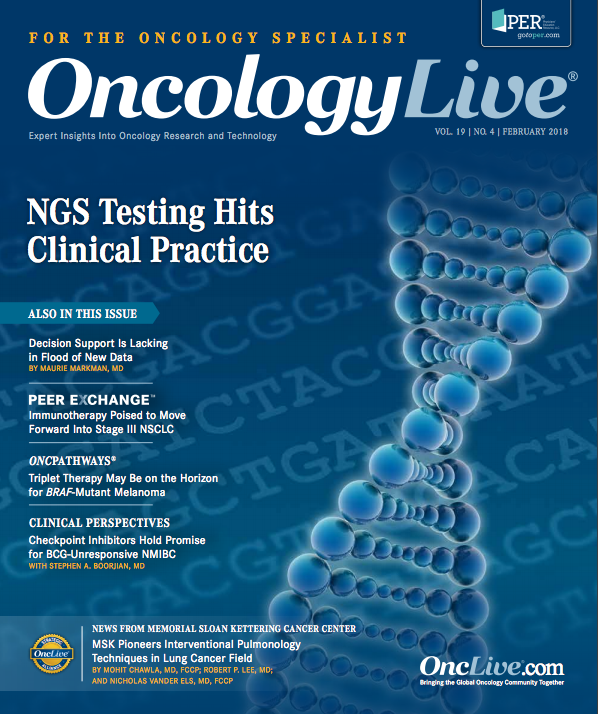Publication
Article
Oncology Live®
Immunotherapy Combination Explored in Unresectable HCC
Author(s):
Investigators are looking into a combination of immunotherapy agents for patients with unresectable hepatocellular carcinoma, for whom there are limited treatment options in the first line.
Ghassan K. Abou-Alfa, MD, Memorial Sloan Kettering Cancer Center

Ghassan K. Abou-Alfa, MD
Investigators are looking into a combination of immunotherapy agents for patients with unresectable hepatocellular carcinoma (HCC), for whom there are limited treatment options in the first line. Researchers think the combination of durvalumab (Imfinzi), a PD-L1 inhibitor, and tremelimumab, a CTLA-4 inhibitor, may be the answer to this clinical need.
According to the National Comprehensive Cancer Network guidelines, the recommended first-line treatments for patients with untreated HCC who are not candidates for transpant include locoregional therapy with ablation, arterially directed therapies, or external beam radiation therapy, or chemotherapy.1 Sorafenib (Nexavar) is the only systemic therapy currentaly approved for patients with unresectable HCC in the first line.1 In 2017, the FDA approved regorafenib (Stivarga) and nivolumab (Opdivo) as second-line treatment options for patients who had previously received sorafenib.2,3
The randomized, multicenter, phase III HIMALAYA trial (NCT03298451) will have 4 arms for patients with previously untreated, unresectable HCC: 2 regimens of durvalumab plus tremelimumab combination therapy, durvalumab monotherapy, and sorafenib monotherapy (FIGURE). The investigators are using overall survival (OS) as the primary endpoint, with time to progression, progression-free survival (PFS), and objective response rate (ORR) as secondary endpoints.
Figure. Durvalumab Plus Tremelimumab in First-Line Unresectable HCC
Prior studies have demonstrated that durvalumab and tremelimumab are active in HCC. Patients who are eligible for the HIMALAYA phase III trial must have had no prior systemic therapy for HCC and have an ECOG performance status of 0 or 1. “This is a population that you care for by using systemic therapy, because there are no other eligible things they can do. They are not eligible for surgeries or local therapy, and as such, they need something that will take care of their disease,” said Ghassan K. Abou-Alfa, MD, medical oncologist and principal investigator for the trial at Memorial Sloan Kettering Cancer Center in New York, New York.
Durvalumab is a human IgG monoclonal antibody and PD-L1 inhibitor that binds to PD-1 and CD80, allowing T cells to recognize and kill tumor cells without the need for cytotoxic activity that is antibody-dependent and cell-mediated.4 Tremelimumab has a similar mechanism, inhibiting CTLA-4, a cell surface receptor that is expressed primarily on activated T cells.5 According to Abou-Alfa, the combination of durvalumab and tremelimumab has a lot of promise in this patient population. The hypothesis is that, due to the way the immune system functions, inhibiting CTLA-4 will increase the activity of the PD-L1 inhibitor.
Early Efficacy Data
“The combination has shown a clear synergy. The anti-CTLA-4 drug will work actively on some of the immune molecules in the lymph nodes and further promote activity of the anti-PD-1 drug, which will affect the tumor itself,” Abou-Alfa explained. “There is a very pure science that tells us that this is, by definition, a more efficient way of getting the response that we are looking for.”In a prior, phase I/II study, 40 patients with HCC were evaluable to assess the safety and tolerability of the drug combination. The confirmed ORR was 17.5%, with 7 patients having a partial response. The ORR on the basis of confirmed and unconfirmed response was 25% (10/40 patients). The median time to response was 8 weeks (range, 7.6-24.0 weeks).6
The combination was also generally well tolerated and exhibited no unexpected safety signals in patients with unresectable HCC. The most common treatment-related adverse events (trAEs) included fatigue (27.5%), increased alanine aminotransferase (ALT; 20%), pruritus (22.5%), and increased aspartate aminotransferase (AST; 17.5%). The most common grade ≥3 trAE was asymptomatic increased AST (10%). At the time the results were presented, 24 patients had discontinued treatment: 3 due to trAEs (grade 3 pneumonitis, grade 3 colitis/diarrhea, and asymptomatic grade 4 elevated AST and ALT); 16 due to progressive disease; and 4 due to death unrelated to treatment (cardiac arrest, variceal bleed, progressive disease, and probable HCC rupture). One patient entered hospice care.6
The 2 drugs are being developed by AstraZeneca, based in Wilmington, Delaware.
References
- Hepatobiliary cancers version 4.2017. NCCN clinical practice guidelines in oncology. National Comprehensive Cancer Network. nccn.org/ professionals/physician_gls/pdf/hepatobiliary.pdf. Published October 9, 2017. Accessed January 17, 2018.
- FDA expands use of Stivarga to treat liver cancer [press release]. Silver Spring, MD: US Food and Drug Administration; April 27, 2017. fda. gov/NewsEvents/Newsroom/PressAnnouncements/ucm555608. htm. Accessed January 17, 2018.
- FDA grants accelerated approval to nivolumab for HCC previously treated with sorafenib [press release]. Silver Spring, MD: US Food and Drug Administration; September 22, 2017. fda.gov/Drugs/ InformationOnDrugs/ApprovedDrugs/ucm577166.htm. Accessed January 17, 2018.
- Durvalumab (MEDI4736, IMFINZI). NIH Division of Cancer Treatment and Diagnosis website. https://nciformulary.cancer.gov/available_ agents/Durvalumab.htm/. Updated June 30, 2017. Accessed January 17, 2018.
- Tremelimumab (CP-675,206). NIH Division of Cancer Treatment and Diagnosis website. https://nciformulary.cancer.gov/available_agents/ Tremelimumab.htm. Updated June 30, 2017. Accessed January 17, 2018.
- Kelley RK, Abou-Alfa GK, Bendell JC, et al. Phase I/II study of durvalumab and tremelimumab in patients with unresectable hepatocellular carcinoma (HCC): phase I safety and efficacy analyses. Presented at: 2017 ASCO Annual Meeting; June 2-6, 2017; Chicago, IL. Abstract 4073. https://meetinglibrary.asco.org/record/147423/abstract.
























%20(2)%201-Recovered-Recovered-Recovered-Recovered-Recovered-Recovered-Recovered-Recovered-Recovered-Recovered-Recovered-Recovered-Recovered-Recovered-Recovered-Recovered-Recovered.jpg?fit=crop&auto=format)
%20(2)%201-Recovered-Recovered-Recovered-Recovered-Recovered-Recovered-Recovered-Recovered-Recovered-Recovered-Recovered-Recovered-Recovered-Recovered-Recovered-Recovered-Recovered.jpg?fit=crop&auto=format)
